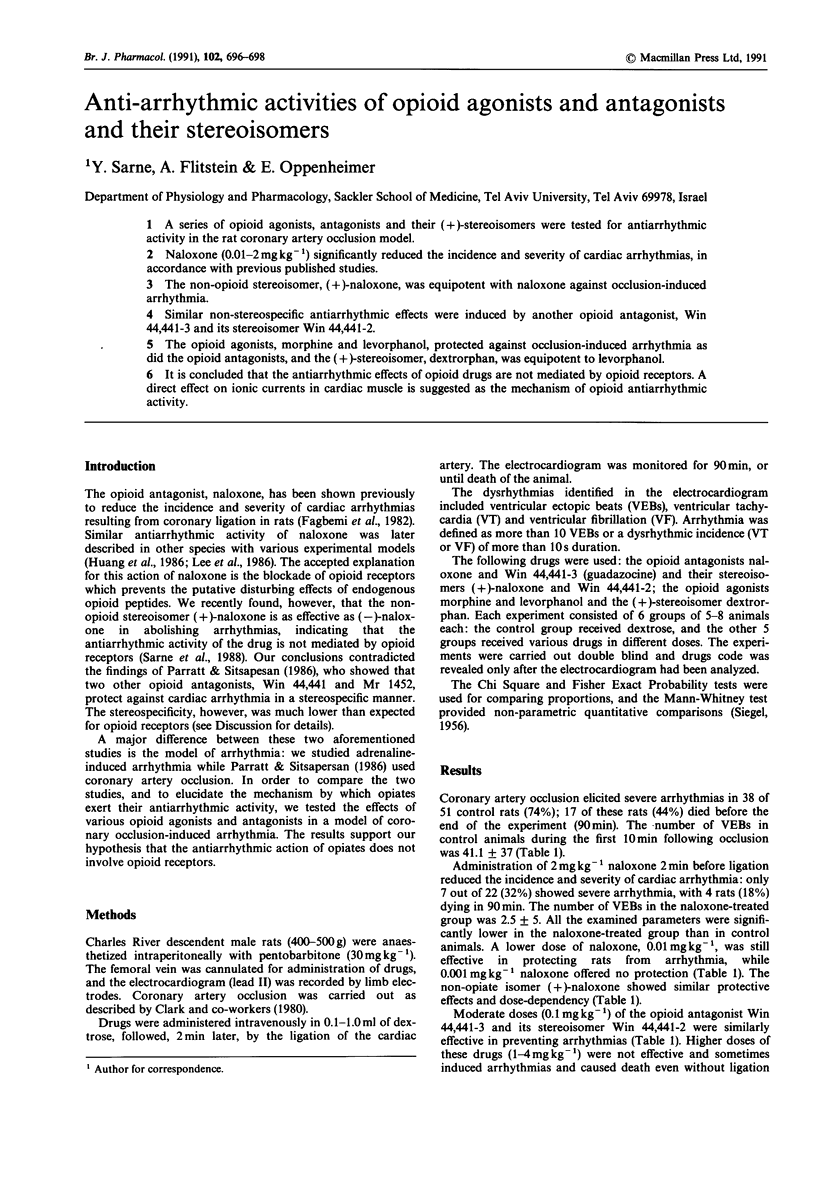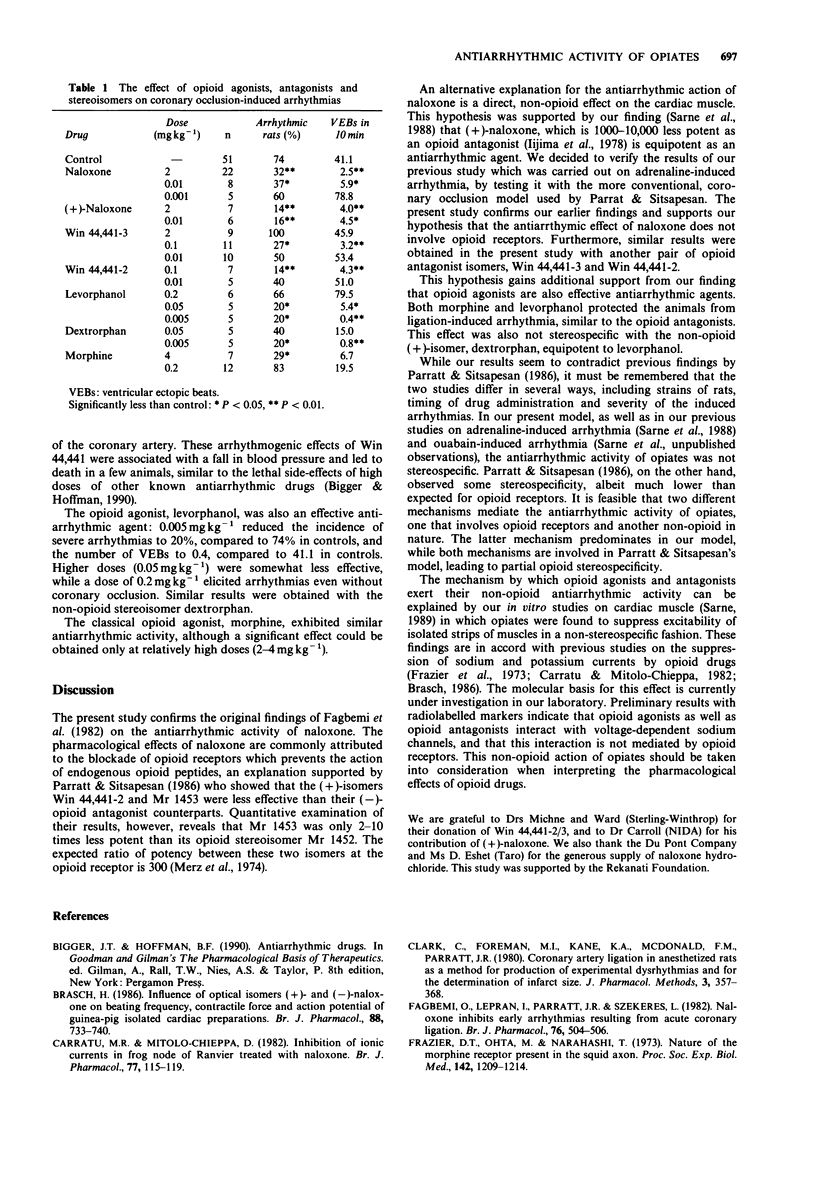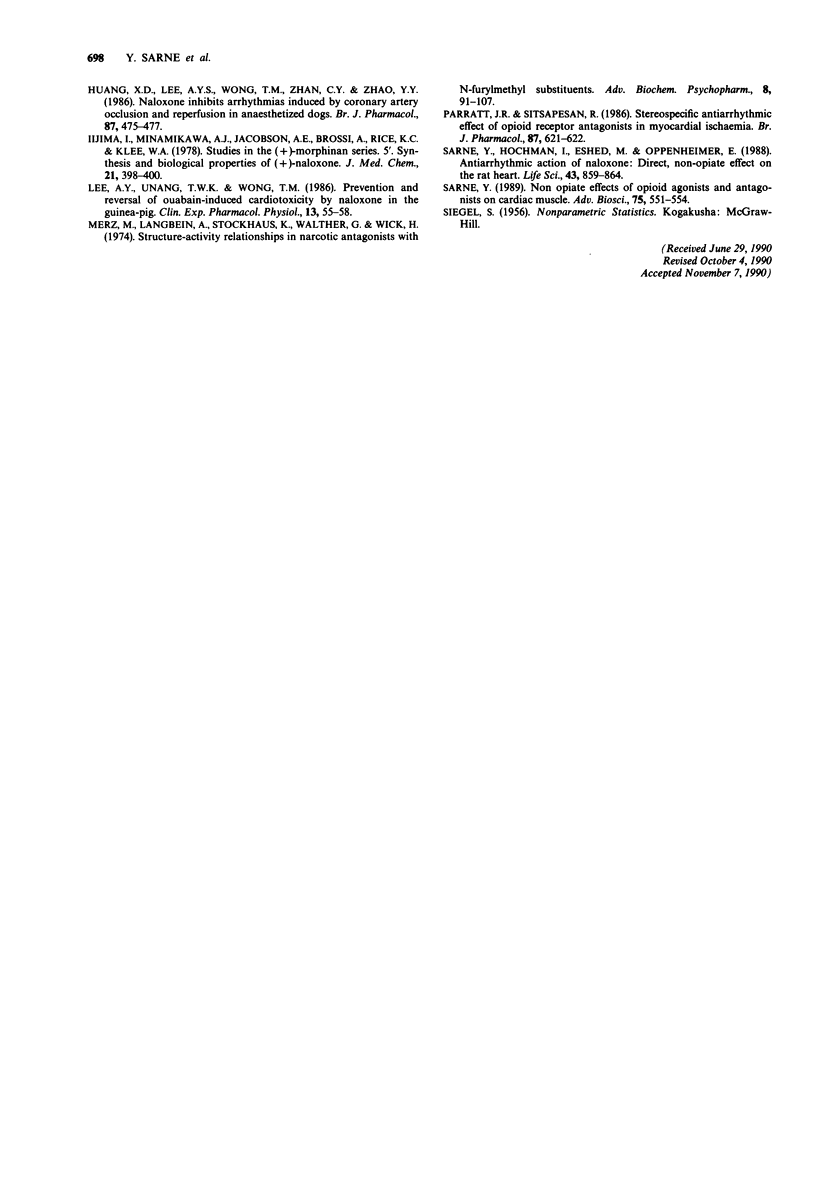Abstract
1. A series of opioid agonists, antagonists and their (+)-stereoisomers were tested for antiarrhythmic activity in the rat coronary artery occlusion model. 2. Naloxone (0.01-2 mg kg-1) significantly reduced the incidence and severity of cardiac arrhythmias, in accordance with previous published studies. 3. The non-opioid stereoisomer, (+)-naloxone, was equipotent with naloxone against occlusion-induced arrhythmia. 4. Similar non-stereospecific antiarrhythmic effects were induced by another opioid antagonist, Win 44,441-3 and its stereoisomer Win 44,441-2. 5. The opioid agonists, morphine and levorphanol, protected against occlusion-induced arrhythmia as did the opioid antagonists, and the (+)-stereoisomer, dextrorphan, was equipotent to levorphanol. 6. It is concluded that the antiarrhythmic effects of opioid drugs are not mediated by opioid receptors. A direct effect on ionic currents in cardiac muscle is suggested as the mechanism of opioid antiarrhythmic activity.
Full text
PDF


Selected References
These references are in PubMed. This may not be the complete list of references from this article.
- Brasch H. Influence of the optical isomers (+)- and (-)-naloxone on beating frequency, contractile force and action potentials of guinea-pig isolated cardiac preparations. Br J Pharmacol. 1986 Aug;88(4):733–740. doi: 10.1111/j.1476-5381.1986.tb16245.x. [DOI] [PMC free article] [PubMed] [Google Scholar]
- Carratu' M. R., Mitolo-Chieppa D. Inhibition of ionic currents in frog node of Ranvier treated with naloxone. Br J Pharmacol. 1982 Sep;77(1):115–119. doi: 10.1111/j.1476-5381.1982.tb09276.x. [DOI] [PMC free article] [PubMed] [Google Scholar]
- Clark C., Foreman M. I., Kane K. A., McDonald F. M., Parratt J. R. Coronary artery ligation in anesthetized rats as a method for the production of experimental dysrhythmias and for the determination of infarct size. J Pharmacol Methods. 1980 Jun;3(4):357–368. doi: 10.1016/0160-5402(80)90077-7. [DOI] [PubMed] [Google Scholar]
- Fagbemi O., Leprán I., Parratt J. R., Szekeres L. Naloxone inhibits early arrhythmias resulting from acute coronary ligation. Br J Pharmacol. 1982 Aug;76(4):504–506. doi: 10.1111/j.1476-5381.1982.tb09246.x. [DOI] [PMC free article] [PubMed] [Google Scholar]
- Frazier D. T., Ohta M., Narahashi T. Nature of the morphine receptor present in the squid axon. Proc Soc Exp Biol Med. 1973 Apr;142(4):1209–1214. doi: 10.3181/00379727-142-37210. [DOI] [PubMed] [Google Scholar]
- Huang X. D., Lee A. Y., Wong T. M., Zhan C. Y., Zhao Y. Y. Naloxone inhibits arrhythmias induced by coronary artery occlusion and reperfusion in anaesthetized dogs. Br J Pharmacol. 1986 Mar;87(3):475–477. doi: 10.1111/j.1476-5381.1986.tb10186.x. [DOI] [PMC free article] [PubMed] [Google Scholar]
- Iijima I., Minamikawa J., Jacobson A. E., Brossi A., Rice K. C. Studies in the (+)-morphinan series. 5. Synthesis and biological properties of (+)-naloxone. J Med Chem. 1978 Apr;21(4):398–400. doi: 10.1021/jm00202a018. [DOI] [PubMed] [Google Scholar]
- Lee A. Y., Unang T. W., Wong T. M. Prevention and reversal of ouabain-induced cardiotoxicity by naloxone in the guinea-pig. Clin Exp Pharmacol Physiol. 1986 Jan;13(1):55–58. doi: 10.1111/j.1440-1681.1986.tb00315.x. [DOI] [PubMed] [Google Scholar]
- Merz H., Langbein A., Stockhaus K., Walther G., Wick H. Structure-activity relationships in narcotic antagonists with N-furylmethyl substituents. Adv Biochem Psychopharmacol. 1973;8(0):91–107. [PubMed] [Google Scholar]
- Parratt J. R., Sitsapesan R. Stereospecific antiarrhythmic effect of opioid receptor antagonists in myocardial ischaemia. Br J Pharmacol. 1986 Apr;87(4):621–622. doi: 10.1111/j.1476-5381.1986.tb14577.x. [DOI] [PMC free article] [PubMed] [Google Scholar]
- Sarne Y., Hochman I., Eshed M., Oppenheimer E. Antiarrhythmic action of naloxone: direct, non-opiate effect on the rat heart. Life Sci. 1988;43(10):859–864. doi: 10.1016/0024-3205(88)90513-9. [DOI] [PubMed] [Google Scholar]


